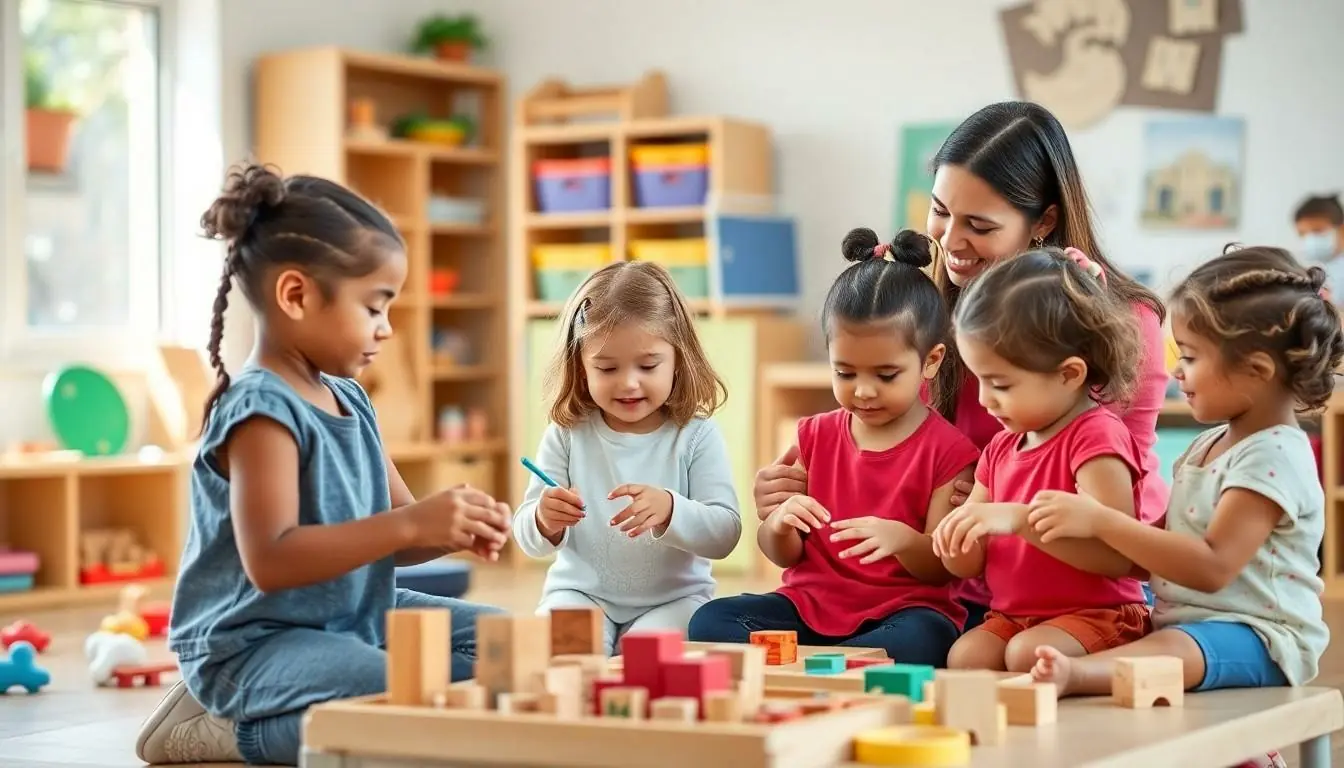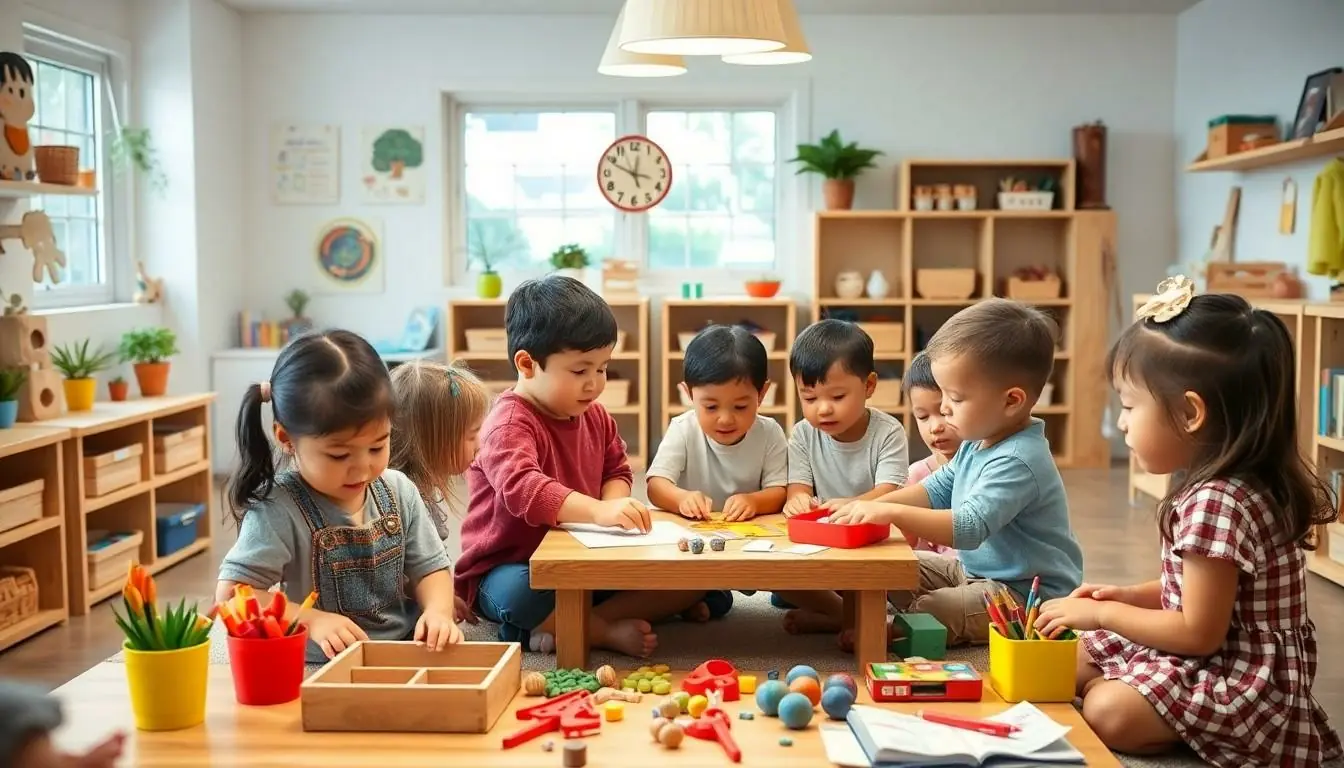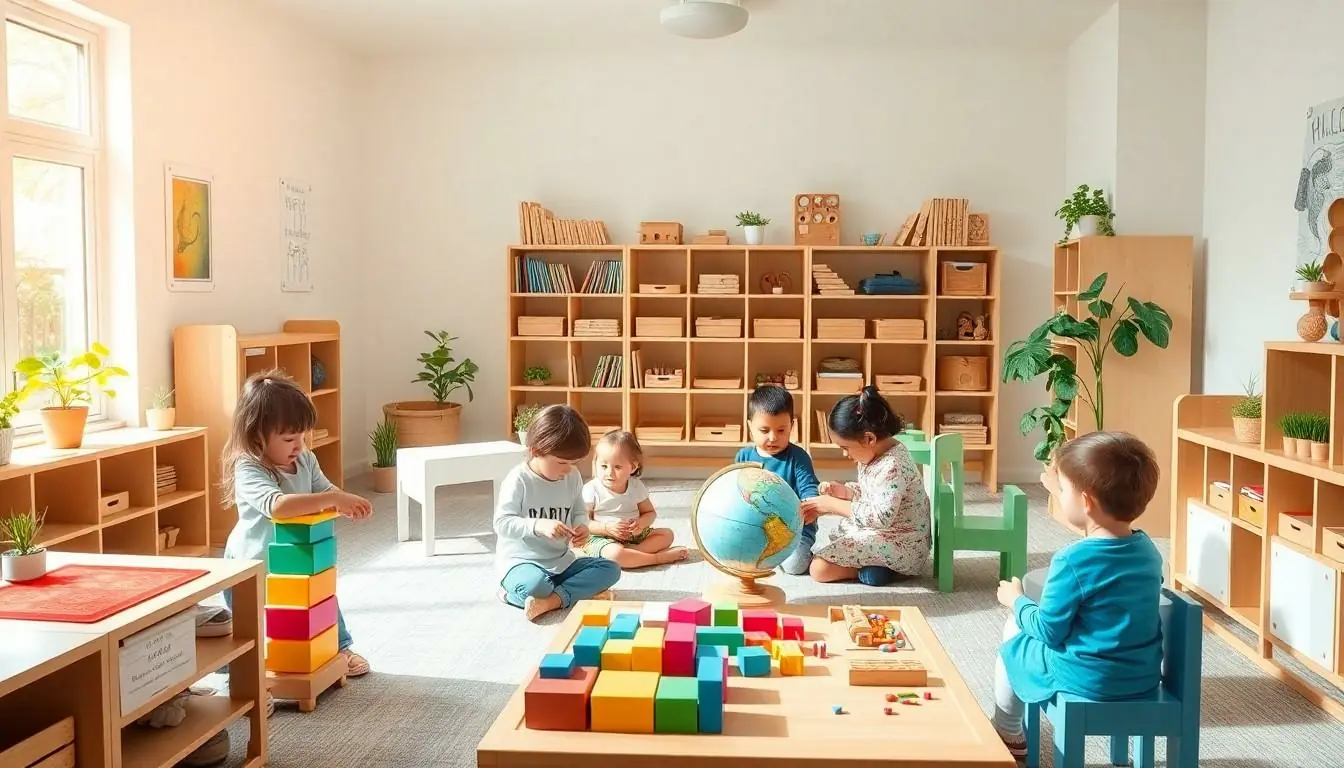Stanford Montessori stands as a beacon of educational excellence, blending the time-tested Montessori method with innovative learning approaches. This prestigious institution has been nurturing young minds and fostering independence for over three decades, creating an environment where children don’t just learn – they thrive.
What sets Stanford Montessori apart is its unique approach to childhood development. Instead of traditional classroom structures where children sit in rows listening to lectures, students engage in hands-on learning experiences that spark curiosity and creativity. Teachers act as guides rather than instructors, allowing each child to discover their own path to knowledge at their own pace. It’s an educational philosophy that’s proven to create confident, capable learners who are ready to take on the world.
Table of Contents
ToggleWhat Is Stanford Montessori Education
Stanford Montessori Education combines traditional Montessori methods with research-based educational practices from Stanford University’s developmental psychology studies. This unique integration creates a dynamic learning environment that emphasizes cognitive development alongside social emotional growth.
Core Principles and Philosophy
Stanford Montessori Education centers on three fundamental principles: respect for individual development patterns individualized learning experiences respect for the child’s natural psychological development. The educational framework incorporates prepared environments with specialized Montessori materials that enable sensory learning exploration. Children engage in uninterrupted work periods allowing them to develop concentration focus task completion skills. Multi-age classrooms foster peer learning mentorship opportunities as older students guide younger ones through various activities.
The Stanford Approach to Montessori
Stanford Montessori distinguishes itself through evidence-based modifications to classic Montessori techniques. Teachers utilize observation tools developed by Stanford researchers to track each child’s developmental progress cognitive growth. The curriculum integrates STEM-focused materials promoting analytical thinking problem-solving abilities. Progressive assessment methods measure both academic achievement social emotional development ensuring comprehensive student growth. Language immersion programs expose children to multiple languages during their peak language acquisition period enhancing cognitive flexibility cultural awareness.
Academic Programs and Curriculum
Stanford Montessori’s academic programs integrate research-based educational practices with traditional Montessori methods. The curriculum spans across developmental stages designed to maximize learning potential during critical growth periods.
Early Childhood Development
The Early Childhood program serves children ages 2.5 to 6 in mixed-age classrooms that foster peer learning opportunities. Students engage with specialized Montessori materials focusing on practical life exercises sensorial exploration mathematics language arts cultural studies. The curriculum incorporates daily activities in:
- Practical Life Skills: buttoning zipping pouring cleaning
- Sensorial Activities: exploring textures shapes sounds weights
- Mathematics: counting sequencing basic operations geometry
- Language Arts: phonics writing reading comprehension
- Cultural Studies: geography science art music
Teachers track developmental milestones through observation tools documenting each child’s progress in cognitive social emotional physical domains.
Elementary Education
Elementary students ages 6 to 12 participate in an integrated curriculum combining core academic subjects with project-based learning. The program includes:
- Mathematics: advanced operations fractions decimals algebra
- Language Arts: creative writing literature grammar research
- Science: biology chemistry physics environmental studies
- Cultural Studies: world history geography civilizations
- Technology: coding digital literacy robotics
- Arts & Expression: music visual arts theater
Students work in three-hour uninterrupted blocks allowing deep concentration independent research. The curriculum emphasizes collaborative projects hands-on experiments field studies connecting classroom learning to real-world applications. Monthly assessments track academic progress while maintaining the Montessori philosophy of individual development.
Campus Facilities and Learning Environment
Stanford Montessori’s campus encompasses 5 acres of purpose-built educational spaces designed to support the Montessori method. The facilities integrate indoor and outdoor learning environments that promote exploration, independence and natural development.
Prepared Classroom Spaces
Each Stanford Montessori classroom features meticulously organized learning zones equipped with specialized Montessori materials. Low-level shelves display materials at child height, encouraging independent access and exploration. Natural lighting floods the rooms through large windows, creating an inviting atmosphere for focused work. The classrooms include dedicated areas for practical life activities, sensorial exercises, mathematics, language arts and cultural studies. Custom-sized furniture accommodates different age groups within the mixed-age setting. Sound-absorbing materials and defined workspace boundaries help maintain the calm, concentrated atmosphere essential to the Montessori approach.
Outdoor Learning Areas
The campus includes 20,000 square feet of outdoor learning spaces designed for experiential education. Children tend organic gardens with seasonal vegetables, herbs and flowers. A natural playground incorporates climbing structures, balance beams and sensory paths made from sustainable materials. The outdoor classroom features weather-protected workspaces for science experiments, art projects and group activities. Native plant gardens attract local wildlife, creating opportunities for nature observation and environmental education. A dedicated movement area supports gross motor development through activities like yoga and dance. The outdoor spaces connect seamlessly to indoor classrooms through covered walkways, allowing fluid transitions between learning environments.
Teaching Methods and Staff Qualifications
Stanford Montessori prioritizes excellence in teaching through rigorous staff training requirements and evidence-based educational approaches. The institution maintains a 1:10 teacher-student ratio to ensure individualized attention for each child’s developmental journey.
Specialized Montessori Training
Stanford Montessori teachers hold Association Montessori Internationale (AMI) or American Montessori Society (AMS) certifications. Each lead teacher completes 400 hours of specialized training including child development theory practical application exercises. The certification process incorporates supervised teaching practice direct observation techniques classroom management strategies. Teachers participate in 50 hours of annual professional development focusing on latest educational research Montessori methodology updates. Faculty members receive training in Stanford University’s developmental psychology protocols to integrate research-based practices into daily instruction.
Student-Teacher Interaction
Teachers at Stanford Montessori act as guides who observe document each child’s progress through detailed learning portfolios. Faculty members conduct daily individual lessons with students using specialized Montessori materials to support concept mastery. Teachers rotate through classroom zones during 3-hour work periods enabling sustained student engagement. The mixed-age classroom structure allows educators to foster peer mentoring relationships between older younger students. Teachers hold bi-weekly conferences with each student to review progress set learning goals provide constructive feedback on development.
| Teaching Qualification Requirements | Duration/Frequency |
|---|---|
| Initial Montessori Certification | 400 hours |
| Annual Professional Development | 50 hours |
| Individual Student Conferences | Bi-weekly |
| Daily Observation Documentation | 3 hours |
Student Development and Achievement
Stanford Montessori’s comprehensive approach to student development focuses on measuring individual progress while nurturing social-emotional competencies. Students demonstrate consistent growth across academic domains through personalized learning paths that adapt to their unique developmental rhythms.
Individual Progress Tracking
Stanford Montessori employs a systematic observation system to document each student’s developmental milestones. Teachers maintain digital portfolios containing 15 weekly data points across cognitive domains including mathematics, language acquisition, practical skills. The assessment framework incorporates 8 key developmental indicators: concentration capacity, work completion, problem-solving abilities, academic mastery, creative expression, motor skills development, organizational capabilities, independence levels. Quarterly progress reports provide detailed analysis of student achievement using concrete metrics rather than traditional grades. Regular parent-teacher conferences occur every 6 weeks to discuss developmental benchmarks and adjust learning strategies according to each child’s pace.
Social and Emotional Growth
Stanford Montessori integrates social-emotional learning through structured peer interactions in mixed-age classrooms. Students develop leadership skills by mentoring younger classmates in 30-minute daily collaborative sessions. The program measures 5 core emotional competencies: self-awareness, relationship management, responsible decision-making, social awareness, self-regulation. Teachers track emotional intelligence development using validated assessment tools from Stanford University’s psychology department. Students participate in 45-minute weekly mindfulness sessions that enhance focus and emotional regulation. Community service projects engage students in 4 annual initiatives that build empathy and social responsibility through real-world applications.
Parent Involvement and Community
Stanford Montessori creates strong partnerships between families and educators through structured engagement programs. Parents participate in 12 classroom observations annually to understand their child’s learning environment. Monthly parent education workshops cover Montessori principles, child development stages, and effective home learning strategies.
The Parent Association organizes 6 major community events each year, including cultural festivals, science fairs, and wellness programs. Families contribute 20 volunteer hours per academic year, supporting classroom activities, maintaining the organic garden, or assisting with administrative tasks.
Stanford Montessori’s community outreach initiatives include:
- Quarterly open houses for prospective families
- Educational partnerships with local libraries offering free Montessori materials
- Community service projects connecting students with senior centers
- Environmental programs maintaining 3 local parks
- Weekly parent coffee meetings with faculty members
Parent communication occurs through:
| Communication Channel | Frequency | Purpose |
|---|---|---|
| Digital Portfolio Updates | Weekly | Student Progress |
| Classroom Newsletters | Bi-weekly | Activity Updates |
| Parent-Teacher Conferences | Every 6 weeks | Development Review |
| Community Forums | Monthly | School Planning |
The school maintains an active parent resource center providing:
- Educational materials for home activities
- Access to Montessori research databases
- Translation services in 5 languages
- Parenting workshops led by certified specialists
- Lending library with 500+ Montessori books
This collaborative approach creates a supportive learning community where parents actively participate in their children’s educational journey while fostering connections among families from diverse backgrounds.
Conclusion
Stanford Montessori stands as a pioneering educational institution that masterfully blends traditional Montessori principles with cutting-edge research and modern teaching methods. Through its carefully designed programs individualized attention and state-of-the-art facilities students develop into confident independent learners.
The school’s commitment to excellence is evident in its rigorous teacher training comprehensive assessment systems and strong parent-community partnerships. Students benefit from a unique educational experience that nurtures both academic achievement and social-emotional growth preparing them for future success.
With its research-based approach specialized learning environments and dedication to continuous improvement Stanford Montessori continues to set the standard for progressive education in the 21st century.




